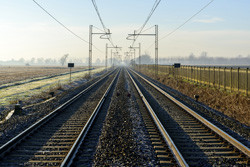Monitoring rail infrastructure moves forward
The rail network is going strong across the EU, transporting goods and people at increasing rates as technologies and standards converge. With this increase and ageing rail systems, however, comes a need to strengthen safety of both wagons and infrastructure. This calls for an effective maintenance strategy and a variety of associated tools. The EU-funded project DIAGNO-RAIL(opens in new window) rose up to the challenge. Envisioning more rapid inspection to reduce risks and costs, the project developed an advanced diagnostic system to better assess risks and predict failure of rail networks. Specifically, it combined visual and magnetic ac-susceptibility methods, which quickly assess track failure, with state-of-the-art acoustic and nuclear magnetic resonance (NMR) portable devices, used to examine concrete structures. This was coupled with an advanced chemical toolkit for onsite chemical analysis measurements, adding another important dimension to safety monitoring and diagnostics. With a focus on non-destructive testing — i.e. not requiring costly dismantling of rail infrastructure or rolling stock — the project developed specific techniques to monitor damage, integrity and failure of track components. This involved a high-definition camera on a rolling vehicle to monitor tracks, along with fast image processing software to monitor other infrastructure from switches and ballasts to crosses and joints. Other equally important technologies included a novel method for magnetic detection of cracks in rail tracks, as well as additional ways to monitor integrity, damage and failure of concrete structures. Also noteworthy are user-friendly software packages to monitor concrete through microseismic sensors and to analyse NMR spectroscopy data. The results of the project, represented by a set of promising methodologies, technologies and tools, were disseminated through publications, conferences, presentations and the project website. Once this easy-to-use solution is adopted, it is expected to improve maintenance, diminish repair costs and enhance safety of the rail system across Europe. It will undoubtedly lead to less downtime of rail systems, enabling people and goods to travel more efficiently and quickly by rail.



